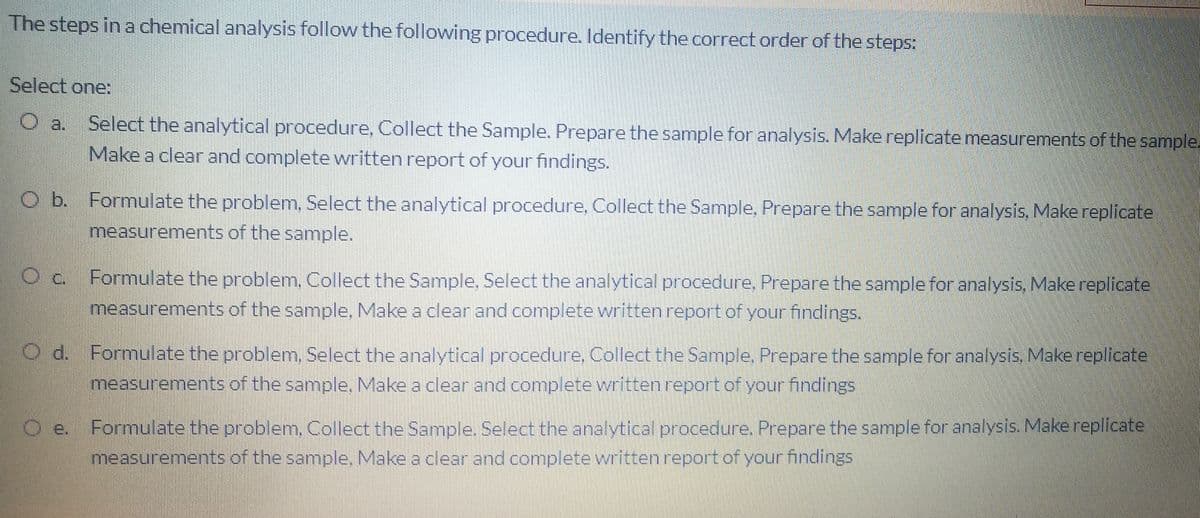Suppose an unknown sample of calcium is to be analysed by gravimetry technique. Which of the following procedure will results in the formation of a pure crystalline precipitate Select one: O a. All of the given statements O b. Ignition aids in recovering precipitate from sintered glass crucible Oc. Encouraging colloidal formation will aid in the recovery of most precipitate from solution O d. Generating a homogeneous precipitating agent increase the likelihood of pure crystals O e. The solutions are mixed rapidly to allow appropriate ions to make contact without interference from other materials
Suppose an unknown sample of calcium is to be analysed by gravimetry technique. Which of the following procedure will results in the formation of a pure crystalline precipitate Select one: O a. All of the given statements O b. Ignition aids in recovering precipitate from sintered glass crucible Oc. Encouraging colloidal formation will aid in the recovery of most precipitate from solution O d. Generating a homogeneous precipitating agent increase the likelihood of pure crystals O e. The solutions are mixed rapidly to allow appropriate ions to make contact without interference from other materials
Chemistry
10th Edition
ISBN:9781305957404
Author:Steven S. Zumdahl, Susan A. Zumdahl, Donald J. DeCoste
Publisher:Steven S. Zumdahl, Susan A. Zumdahl, Donald J. DeCoste
Chapter1: Chemical Foundations
Section: Chapter Questions
Problem 1RQ: Define and explain the differences between the following terms. a. law and theory b. theory and...
Related questions
Question

Transcribed Image Text:Suppose an unknown sample of calcium is to be analysed by gravimetry technique. Which of the following procedure will results in the
formation of a pure crystalline precipitate
Select one:
O a. All of the given statements
Ob. Ignition alds in recovering precipitate from sintered glass crucible
Encouraging colloldal formation will aid in the recovery of most precipitate from solution
O c.
Od. Generating a homogeneous precipitating agent increase the likelihood of pure crystals
O e The solutions are mixed rapidly to allow appropriate lons to make contact without interference from other materials

Transcribed Image Text:The steps in a chemical analysis follow the following procedure. Identify the correct order of the steps:
Select one:
Select the analytical procedure, Collect the Sample. Prepare the sample for analysis. Make replicate measurements of the sample.
O a.
Make a clear and complete written report of your findings.
O b. Formulate the problem, Select the analytical procedure, Collect the Sample, Prepare the sample for analysis, Make replicate
measurements of the sample.
Formulate the problem, Collect the Sample, Select the analytical procedure, Prepare the sample for analysis. Make replicate
measurements of the sample, Make a clear and complete written report of your findings.
O d. Formulate the problem, Select the analytical procedure, Collect the Sample, Prepare the sample for analysis. Make replicate
measurements of the sample, Make a clear and complete written report of your findings
Formulate the problem, Collect the Sample. Select the analytical procedure. Prepare the sample for analysis. Make replicate
measurements of the sample. Make a clear and complete written report of your findings
Oe.
Expert Solution
This question has been solved!
Explore an expertly crafted, step-by-step solution for a thorough understanding of key concepts.
Step by step
Solved in 2 steps

Knowledge Booster
Learn more about
Need a deep-dive on the concept behind this application? Look no further. Learn more about this topic, chemistry and related others by exploring similar questions and additional content below.Recommended textbooks for you

Chemistry
Chemistry
ISBN:
9781305957404
Author:
Steven S. Zumdahl, Susan A. Zumdahl, Donald J. DeCoste
Publisher:
Cengage Learning

Chemistry
Chemistry
ISBN:
9781259911156
Author:
Raymond Chang Dr., Jason Overby Professor
Publisher:
McGraw-Hill Education

Principles of Instrumental Analysis
Chemistry
ISBN:
9781305577213
Author:
Douglas A. Skoog, F. James Holler, Stanley R. Crouch
Publisher:
Cengage Learning

Chemistry
Chemistry
ISBN:
9781305957404
Author:
Steven S. Zumdahl, Susan A. Zumdahl, Donald J. DeCoste
Publisher:
Cengage Learning

Chemistry
Chemistry
ISBN:
9781259911156
Author:
Raymond Chang Dr., Jason Overby Professor
Publisher:
McGraw-Hill Education

Principles of Instrumental Analysis
Chemistry
ISBN:
9781305577213
Author:
Douglas A. Skoog, F. James Holler, Stanley R. Crouch
Publisher:
Cengage Learning

Organic Chemistry
Chemistry
ISBN:
9780078021558
Author:
Janice Gorzynski Smith Dr.
Publisher:
McGraw-Hill Education

Chemistry: Principles and Reactions
Chemistry
ISBN:
9781305079373
Author:
William L. Masterton, Cecile N. Hurley
Publisher:
Cengage Learning

Elementary Principles of Chemical Processes, Bind…
Chemistry
ISBN:
9781118431221
Author:
Richard M. Felder, Ronald W. Rousseau, Lisa G. Bullard
Publisher:
WILEY